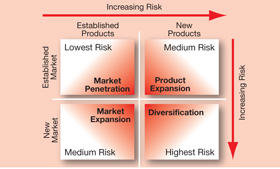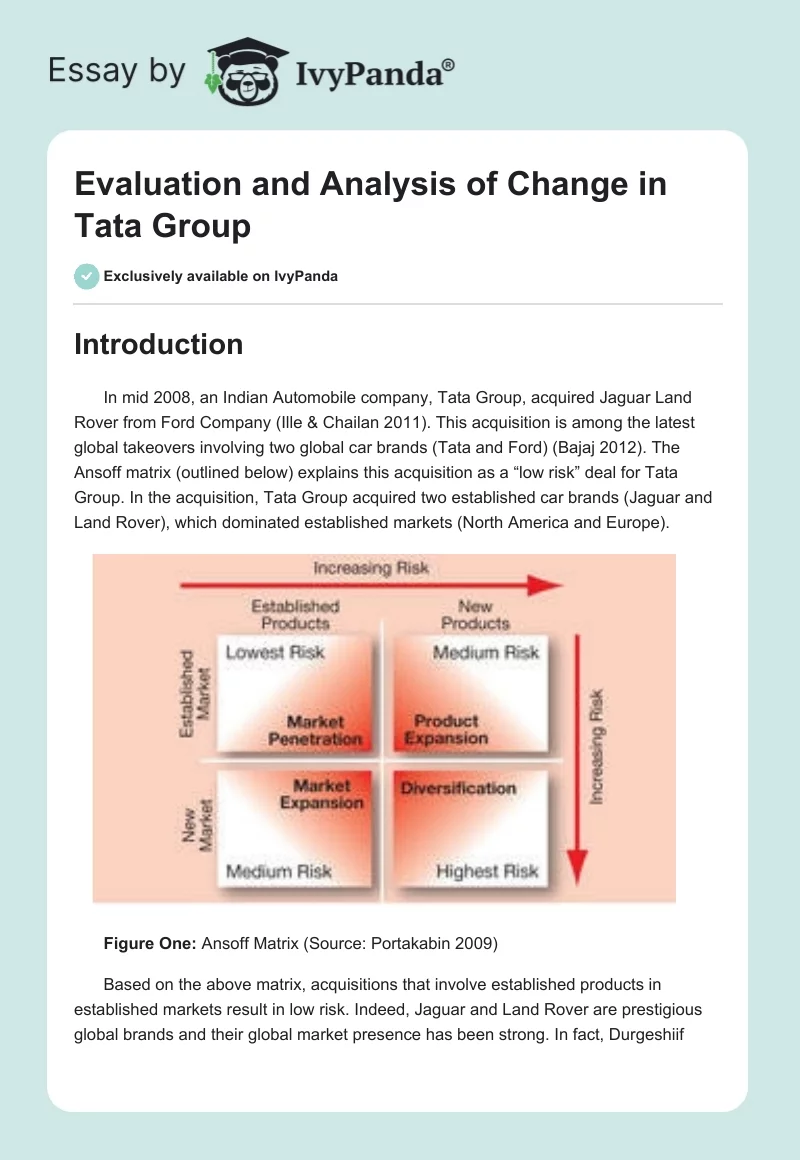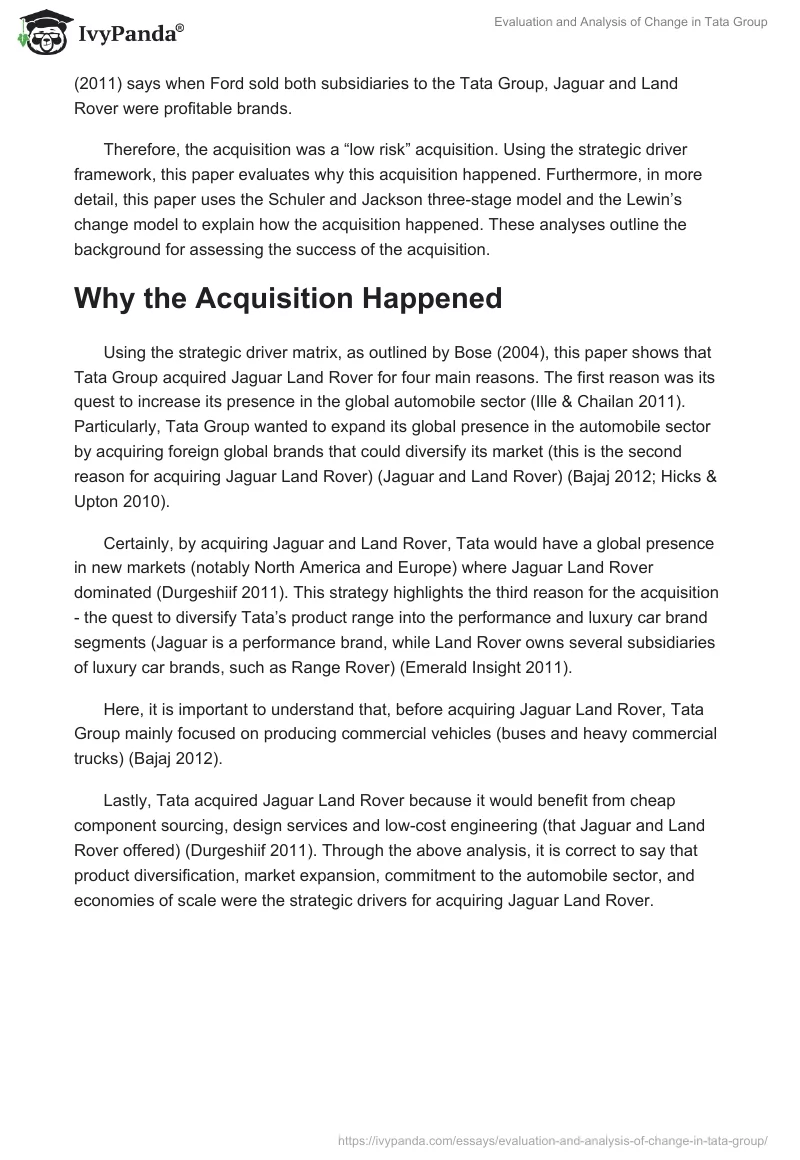Introduction
In mid 2008, an Indian Automobile company, Tata Group, acquired Jaguar Land Rover from Ford Company (Ille & Chailan 2011). This acquisition is among the latest global takeovers involving two global car brands (Tata and Ford) (Bajaj 2012). The Ansoff matrix (outlined below) explains this acquisition as a “low risk” deal for Tata Group. In the acquisition, Tata Group acquired two established car brands (Jaguar and Land Rover), which dominated established markets (North America and Europe).

Based on the above matrix, acquisitions that involve established products in established markets result in low risk. Indeed, Jaguar and Land Rover are prestigious global brands and their global market presence has been strong. In fact, Durgeshiif (2011) says when Ford sold both subsidiaries to the Tata Group, Jaguar and Land Rover were profitable brands.
Therefore, the acquisition was a “low risk” acquisition. Using the strategic driver framework, this paper evaluates why this acquisition happened. Furthermore, in more detail, this paper uses the Schuler and Jackson three-stage model and the Lewin’s change model to explain how the acquisition happened. These analyses outline the background for assessing the success of the acquisition.
Why the Acquisition Happened
Using the strategic driver matrix, as outlined by Bose (2004), this paper shows that Tata Group acquired Jaguar Land Rover for four main reasons. The first reason was its quest to increase its presence in the global automobile sector (Ille & Chailan 2011). Particularly, Tata Group wanted to expand its global presence in the automobile sector by acquiring foreign global brands that could diversify its market (this is the second reason for acquiring Jaguar Land Rover) (Jaguar and Land Rover) (Bajaj 2012; Hicks & Upton 2010).
Certainly, by acquiring Jaguar and Land Rover, Tata would have a global presence in new markets (notably North America and Europe) where Jaguar Land Rover dominated (Durgeshiif 2011). This strategy highlights the third reason for the acquisition – the quest to diversify Tata’s product range into the performance and luxury car brand segments (Jaguar is a performance brand, while Land Rover owns several subsidiaries of luxury car brands, such as Range Rover) (Emerald Insight 2011).
Here, it is important to understand that, before acquiring Jaguar Land Rover, Tata Group mainly focused on producing commercial vehicles (buses and heavy commercial trucks) (Bajaj 2012).
Lastly, Tata acquired Jaguar Land Rover because it would benefit from cheap component sourcing, design services and low-cost engineering (that Jaguar and Land Rover offered) (Durgeshiif 2011). Through the above analysis, it is correct to say that product diversification, market expansion, commitment to the automobile sector, and economies of scale were the strategic drivers for acquiring Jaguar Land Rover.
How it Happened
Schuler and Jackson Three-Stage Model
Schuler and Jackson proposed three stages of mergers and acquisitions. The first stage is the pre-combination stage, which includes the identification and clarification of the reasons for engaging in mergers and acquisitions (Martinez-Fierro & Garrido 2006). The pre-combination stage also involves undertaking proper due diligence for a merger or acquisition (Singal & Jain 2014).
Later, the designing of an integration process should occur in this process. Broadly, this stage outlines the first stages of the Tata and Jaguar Land Rover acquisition because Tata conducted a proper due diligence of the merger by affirming the purpose of the acquisition. As explained in this paper, expansion and diversification motives informed the acquisition.
The second stage of Schuler and Jackson’s three-stage model of mergers and acquisitions outlines the combination stage of mergers and acquisitions (Martinez-Fierro & Garrido 2006).
This stage explores how companies manage transitions, integrate operational processes, and design new structures, processes, and systems of operation (Martinez-Fierro & Garrido 2006). This stage explains the integration plan of Tata and Jaguar Land Rover because Tata integrated its new subsidiary into the company’s business plan, as an independent entity.
The last stage of Jackson’s three-stage model is the solidification stage (Martinez-Fierro & Garrido 2006). This stage explains how companies create new entities after a merger or acquisition. The proper integration of Jaguar Land Rover into Tata’s business plan explains this stage. Since Jaguar Land Rover now operates as a profitable subsidiary of Tata Group, Lewin’s change model also explains how the merger became a success.
Lewin’s Change Model
Lewin’s change model suggests that most organisations undergo three stages of change to be successful – unfreezing, transition, and freezing stages (Liu & Akram 2011). The unfreezing stage involves acknowledging change processes and “dismantling” mental barriers that prevent change (Burnes 2009). The unfreezing stage occurred in the Tata and Jaguar Land Rover acquisition because a stagnant growth in Tata’s market expansion and product diversification strategies created the need for change (Oliver & Holweg 2008).
Particularly, Tata had little, or no, success in global markets (Emerald Insight 2008). The company’s management was not contented with this situation (Emerald Insight 2008). It needed to expand its success beyond India and compete with other global car giants, such as GM (Bell 2013). This need led Tata to conceive the Jaguar Land Rover deal.
The transition stage is the second process in Lewin’s change model. This stage suggests that change is not an event, but a process (Kezar 2001). The transition stage explains Tata’s purchase and investments of billions of Euros to acquire and restructure Jaguar Land Rover.
At this stage, Tata invested a lot of money to research and produce new luxury brands when Europe was experiencing an economic crisis (Gribben 2014). Within the same investment framework, Tata invested a lot of money in recruiting and training new employees to conduct more research on product development (Gribben 2014). These changes contributed to the success of the acquisition.
The last stage of Lewin’s change model is the freezing stage. This stage involves creating stability after organisational change (Liu & Akram 2011). Today, Tata seeks to cement its Jaguar Land Rover success by developing new assembly plants in its strongest markets – China and the Middle East (Gribben 2014). However, the Indian company also strives to develop new talent by recruiting new graduates, who intend to continue the company’s success story as a global automotive leader, by pursuing engineering more seriously (Gribben 2014).
Evaluation of the Acquisition
Tata’s acquisition of Jaguar Land Rover has been largely successful. For example, Tata has reported a strong financial performance in 2012 after launching two new brands, Jaguar F-Type and the new Range Rover Sport (Krishnan 2012). In 2011, the company achieved remarkable success after surpassing its sales target for the Evoque and Range Rover brands (Mann & Kohli 2012). Particularly, the company reported an impressive sales figure for the Evoque brand (JLR 2013).
The company’s profitability shows the same success because between 2010 and 2013, the company reported a significant rise in its profitability (JLR 2013). For example, the company’s financial reports show that, within this period, the company’s profitability increased from £349 million (in 2010) to about £2,402 million in 2013 (JLR 2013).
The company’s sales turnover volumes also show a significant growth in the post-merger period. For example, between 2010 and 2011, the company’s turnover increased by about 26% (JLR 2013). The company’s turnover also increased between 2011 and 2012 by about 29% (JLR 2013). The turnover increase for 2013 was 18%. This trend shows that increased sales turnover characterised the post-merger period. These figures have supported the company’s profitability.
An analysis of Tata’s stock prices also shows an impressive financial performance (NYSE 2014). Indeed, acquiring Jaguar Land Rover led to a significant rise in Tata’s stock prices. The company reported the highest stock prices in late 2010 when the stock price reached $31.83 per share (NYSE 2014). Overall, the company’s stock prices (between 2008 and 2014) show a significant increase in stock prices from about $4.15 in 2009 to $28.86 in 2014 (NYSE 2014). These financial indices show that the acquisition was successful.
Conclusion
After weighing the findings of this study, we see that Tata Group has undergone a significant organisational change through the Jaguar Land Rover acquisition. Notably, the company has revamped its image through this acquisition. The success of flagship brands such as the Evoque and the Jaguar F-type brands have supported this success. The strategic driver matrix shows that the main motivations for acquiring Jaguar Land Rover were product diversification, market expansion, commitment to the automobile sector, and economies of scale. Most of these motivations fit in the company’s growth strategy. Increases in the company’s shareholder value, sales turnover, and profitability indices affirm this fact. Although many analysts were pessimistic about the merger, an analysis of Tata’s financial indices shows that the acquisition was successful.
References
Bajaj, V. 2012, Tata Motors Finds Success in Jaguar Land Rover. Web.
Bell, G. 2013, ‘Restoring trust in the corporation: an interview with Colin Mayer, Peter Moores Professor of Management Studies at Said Business School, and author of Firm Commitment’, Strategic Direction, vol. 29. no. 6, pp. 35 – 39.
Bose, S. 2004, ‘Measuring strategic value-drivers for managing intellectual capital’, Learning Organization, vol. 11. no. 4, pp. 347 – 356.
Burnes, B. 2009, Managing Change (5th Edition), Prentice Hall, London.
Durgeshiif, B. 2011, Tata Motors Acquisition of Jaguar. Web.
Emerald Insight 2008, ‘Neighbours fight off Third World label: India’s Tata and China’s Lenovo help spread the global word’, Strategic Direction, vol. 24. no. 8, pp. 6 – 8.
Emerald Insight 2011, ‘Jaguar Land Rover bosses get to grips with performance management: Program teaches practical skills for the workplace’, Human Resource Management International Digest, vol. 19. no. 4, pp. 10-12.
Gribben, R. 2014, Jaguar Land Rover: £1.3bn Tata gamble pays off as big cat purrs at last. Web.
Hicks, J. & Upton, S. 2010, ‘Jaguar Land Rover transition to high performance training program’, Industrial and Commercial Training, vol. 42. no. 5, pp. 247 – 250.
Ille, F. & Chailan, C. 2011, ‘Improving global competitiveness with branding strategy: Cases of Chinese and emerging countries’ firms’, Journal of Technology Management in China, vol. 6. no. 1, pp. 84 – 96.
JLR 2013, Jaguar Land Rover Overview. Web.
Kezar, A. 2001, Understanding and Facilitating Organizational Change in the 21st Century, Wiley, London.
Krishnan, R. 2012, ‘Innovation strategies of Indian market leaders’, Journal of Indian Business Research, vol. 4. no. 2, pp. 92 – 96.
Liu, X. & Akram, S. 2011, Change Management for Semantic Web Services, Springer, New York.
Mann, B. & Kohli, R. 2012, ‘Do brand acquisitions create wealth for acquiring company shareholders? Evidence from India’, Journal of Product & Brand Management, vol. 21. no. 4, pp. 265 – 274.
Martinez-Fierro, S. & Garrido, J. 2006, Utilizing Information Technology in Developing Strategic Alliances Among Organizations, Idea Group Inc (IGI), London.
NYSE 2014, Tata Motors Limited (ADR). Web.
Oliver, N. & Holweg, M. 2008, ‘A systems perspective on the death of a car company’, International Journal of Operations & Production Management, vol. 28. no. 6, pp. 562 – 583.
Portakabin, A. 2009, Ansoff’s Matrix. Web.
Singal, A. & Jain, A. 2014, ‘Emerging market firms: measuring their success with strategic positioning maps’, Journal of Business Strategy, vol. 35. no. 1, pp. 20 – 28.


